This post may contain affiliate links. Please read my disclosure policy.
I'm not a diabetic, but for the last few months, I've been wearing a Continuous Glucose Monitor (CGM) to track my blood sugars day and night. It has been an eye-opening experience and I've learned a TON about what affects me and how to better control my blood sugars. Here are my main takeaways and aha moments!
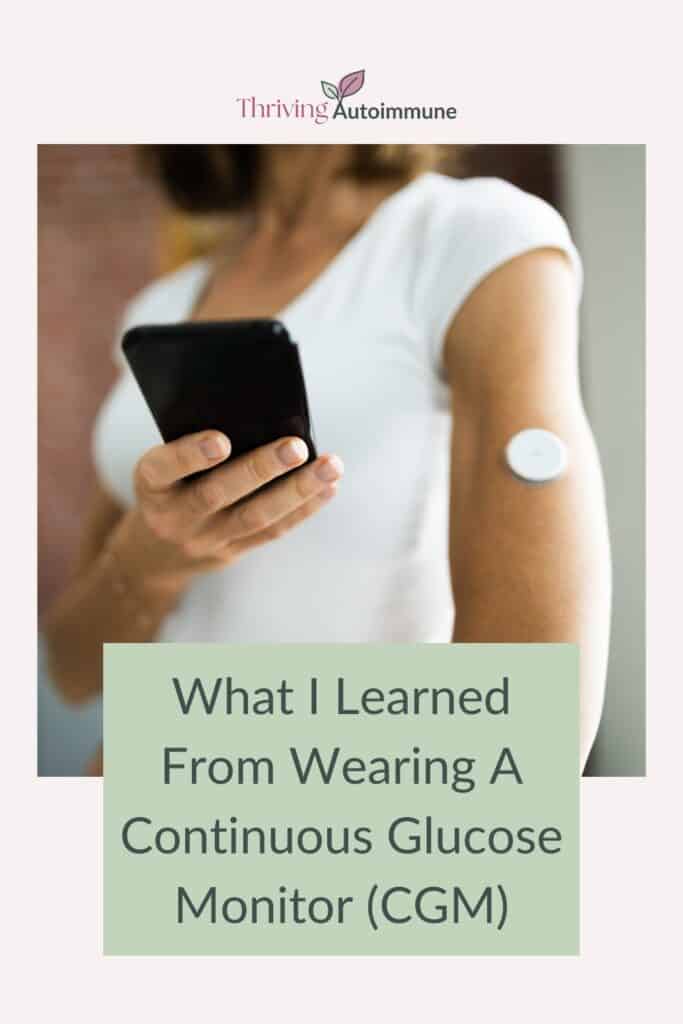
Why did I care about my blood sugar?
Unfortunately, there is a very big link between Hashimoto’s Thyroiditis (which I have) and/or hypothyroidism and carbohydrate intolerance and dysglycemia – which is the inability to tolerate carbs and keep blood sugars stable.
Because yay for us with autoimmune disease, especially those of us with thyroid, adrenal, and hormonal issues – we can’t tolerate carbs as well as the general population.
And if we do NOT address this blood sugar stuff we’ll never feel our absolute best, nor will we stay in a stable, symptom-free place.
If you haven't watched or read the first two videos in the Blood Sugar and Autoimmune Disease Series – it's helpful to do so you can understand why blood sugar fluctuations are so bad for autoimmune disease control and long-lasting health.
- Post # 1 – How Blood Sugar Affects Autoimmune Disease
- Post # 2 – How to know if YOUR blood sugar is affecting your autoimmune disease
I fully believe that many of my flares are due to blood sugar imbalances, so first, I wanted to understand what’s going on with me in terms of blood sugar, and then secondly, I wanted to try to balance them to see if it made a difference.
Rather watch the video?
Here's the video I recorded about this – you can either watch this or just skip ahead and read everything below!
Why wear a CGM?
My son Nathan was diagnosed with Type 1 Diabetes in February 2021. For the first few months, we had to do finger pricks on a glucose meter with him to check his blood sugars. We were taught to do this before a meal and then again 2 hours after. This was mainly so we could adjust his insulin amount and give him more if his blood sugar was too high, but it was just a few numbers throughout the day that we saw.
However, once we got him on a Continuous Glucose Meter we learned a LOT – not only about what his blood sugars we ACTUALLY doing because of meals, but also what exercise, stress, altitude, etc. did as well.
It was an eye-opener and made me really wonder what might be going on with me.
I had been doing some finger pricks on an occasional basis at the time, but really wondered what CGM could tell me. I've struggled with hypoglycemia (low blood sugars) for years and metabolic issues like this are so intertwined with Hashimoto's so I knew I could benefit from knowing more.
I started using a CGM through a program called Levels (this is NOT a sponsored post).
I figured I’d try it for a month, but I’ve learned so much that I've kept going. It’s been one of the most insightful tools I’ve ever used.
Your results might be completely different than mine
And before I get into this I also want to mention that the things I experienced and discovered about myself are not advice for you to follow. What worked and didn't work for me may be completely different for you!
We are all individuals and what might spike my blood sugar might not do anything for you at all or even make you go low. I just want to share what happened to me – but do your own research and experimentation to find out what happens to you.
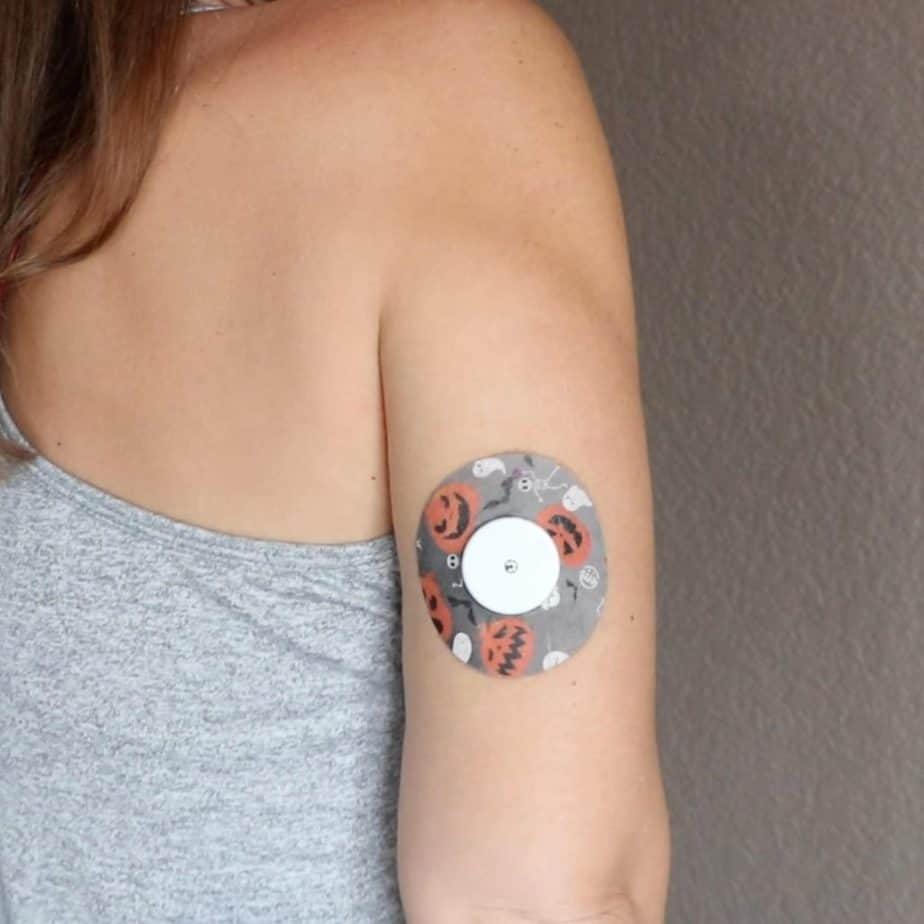
My biggest takeaways:
Before I get into the details, here are 3 of my biggest takeaways from wearing a CGM:
Takeaway # 1: I've always thought that when I was shaky, tired, and CRAVING sugar that it was from me having low blood sugar. But through this, I've learned that if I eat too many carbs in a meal, this is what happens when I have HIGH blood sugar. It was the complete opposite of what I expected and I had been doing the absolute wrong thing by eating MORE sugar/carbs to make it go away! Oops!
This also correlates with my mid-afternoon exhaustion too – I always thought my desire to sleep in the afternoon was a result of some adrenal issues or low blood sugars, but nope, high blood sugars!
Takeaway # 2: I learned that my breakfasts in particular had been spiking my blood sugar super high EVERY DAY. No wonder I felt tired for the rest of the day and was on a blood sugar roller coaster. Luckily I only had to make some minor tweaks and things are much better now. I'll get into that more in a bit though.
Takeaway # 3: My blood sugar is almost like a barometer for stress. Stress of any kind, whether it was heat, too much intensity in a workout, too much working out without recovery, lack of sleep, actual stress itself, etc – they all raised my blood sugar without food. I’m assuming this is a reflection of my body making the stress hormone cortisol but I always tended to have overall higher blood sugars when I was under more stress than usual.
How the Levels Health App and CGM works:
A CGM is a small device, typically worn on your arm or abdomen, for 10-14 days. It's just a small whisker-like wire that sticks into your skin and measures the glucose in the interstitial fluid between your cells. It’s painless and you don’t even know it’s there.
The benefit of a CGM though is that it measures your glucose every 5 minutes, all day and all night, so you can get a really good picture of what your blood sugar is doing.
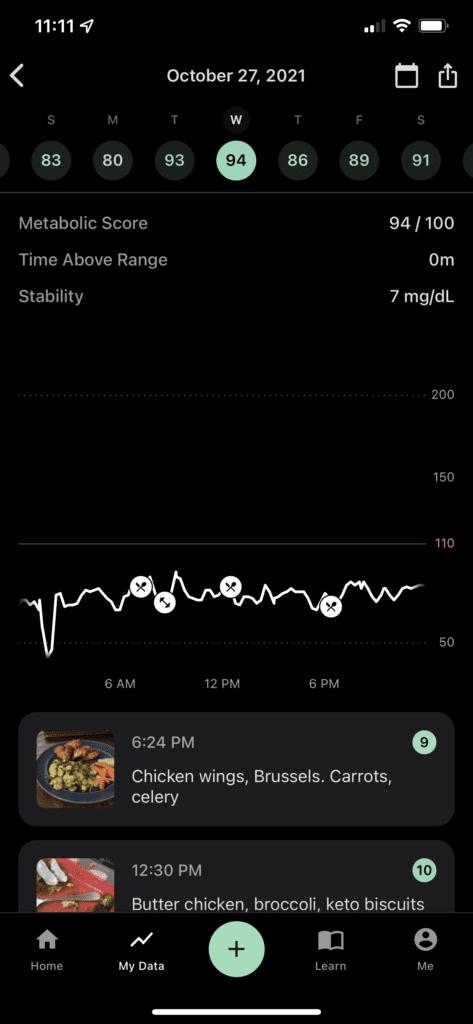
The data is imported automatically into the Levels app, with a bit of a delay (I think it’s an hour?) but then you can use it to really dig deep into what’s happening to you.
Meal Entry
You can enter a meal into the app, complete with an optional picture of your meal, and then 2 hours after the meal the app will give that meal a score from 1-10.
1 being that that meal spiked your blood sugar considerably and for a long period of time, like this:
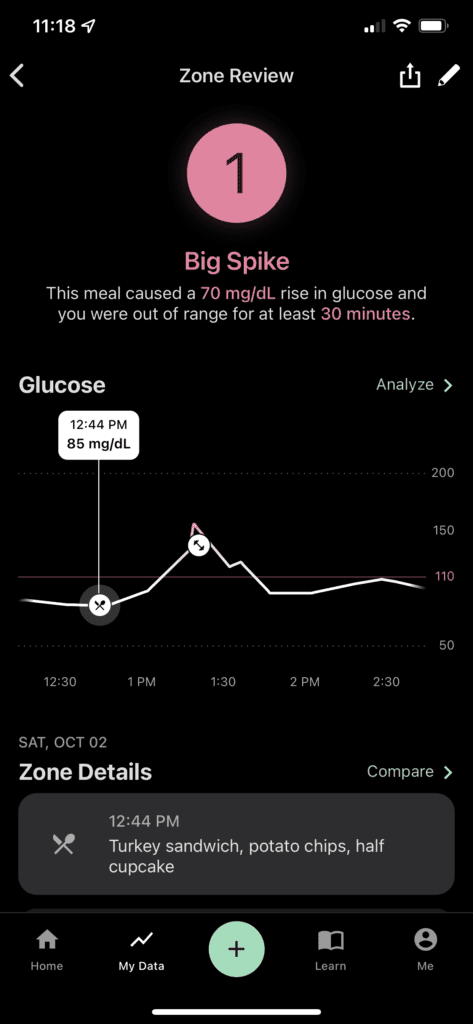
And 10 is that it didn’t affect it much at all, like this:
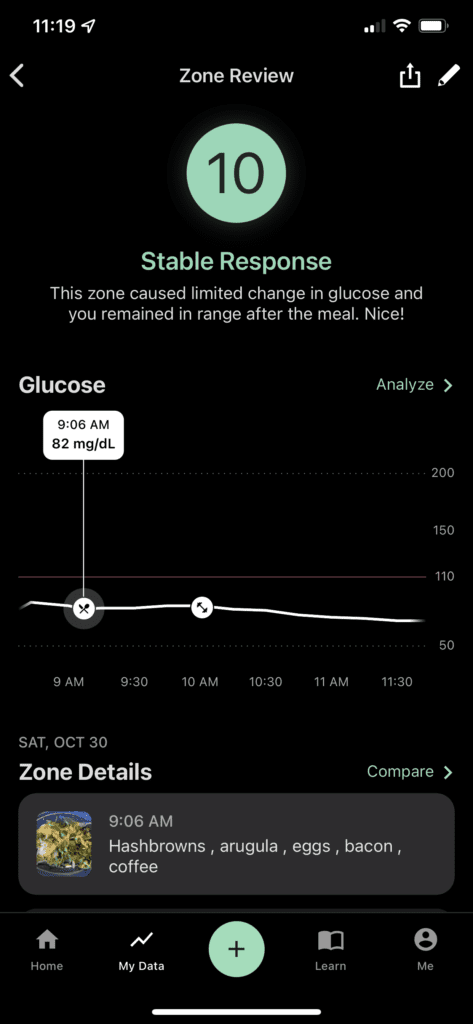
I love this visual for seeing what certain meals do to my blood sugars. Plus there is also a certain amount of gamification of it – no one really wants to see that they got a 1 on a meal!
But it helped me to make adjustments – like the breakfasts I had mentioned being so bad for me were constantly scoring 1-3 every morning!
I had been drinking a small glass of orange juice each morning (maybe a 1/2 cup at most) because I was taking a powdered probiotic that I just couldn’t stand in water. I experimented by removing that and switching to a different probiotic and I was able to raise my scores up to 7-8 each morning!
And then we do often have Paleo pancakes because it’s just an easy thing to freeze and access each morning, but when I had it with maple syrup my scores would still be low. So I switched to either smearing some nut butter on my pancakes, using some stewed berries, or using whipped coconut cream and my scores went up to 9's and 10's.
It didn't take a major overhaul of what I was eating, just a few tweaks and suddenly my blood sugars were SO much better!
Workout data also counts
Levels also brings in workout data as well, and will give you a combined score for a meal plus a workout if it's within 2 hours of eating. So for example, if I have breakfast and then go walk the dogs for 45 minutes, I might see a different (usually better) score than if I just had breakfast and sat on my butt doing nothing.
How I went about using the CGM:
For the first month of wearing the CGM I went back to eating whatever I wanted (always gluten-free because I have Celiac disease). But things like GF pasta, rice, muffins, chicken nuggets, etc. were back on the table. I really wanted to see what these did to my blood sugars.
Let’s just say it wasn’t good. I mean, not surprising, but it was good to SEE evidence of it like this. And it probably explains a bit why I DO have a flare-up of my Hashimoto's symptoms if I do eat these things a lot.
From there though I started making adjustments to see what would make a difference.
Did brown rice spike my blood sugar less than white rice?
One of the things I tried was seeing if switching from a super high glycemic, empty carb like white rice to whole-grain brown rice would make a difference. It didn't seem to make any difference for me though – it was like rice was rice was rice. Didn't matter if it was white or brown or wild or black or whatever – they all spiked my blood sugar in the same way.
Did the quantity of a particular carb matter?
I also played around with the quantity of a particular carb, as I wanted to see if having as much as I wanted affected me differently than only having 1 cup of it, or even only having 1/2 cup of it. This actually made quite a big difference and I learned that I definitely cannot do “as much as I want” anymore. But 1/2 cup of something like rice or sweet potatoes doesn't seem to have too much of an effect on my blood sugar.
What about eating carbs with protein, fat, and fiber?
Another thing I played around with was the amount of protein, fat, and fiber I ate with carbs in a meal. These definitely did what we always say with conventional wisdom – when I ate a balanced meal my blood sugar would be more stable. And eating a carb, like some fruit, by itself without any protein, fat, or fiber caused a spike.
But even when eating a balanced meal it still really mattered WHAT kind of carb I had. I, for example, would still have a pretty big spike if I ate a bowl of cassava flour pasta with olive oil, broccoli, and chicken. But a bowl of chicken, broccoli, and sweet potatoes wouldn’t spike my blood sugar all that much.
Did high fiber carbs affect me?
Another thing I experimented with were high fiber carbs, as many experts and dieticians always say these are the best for your blood sugar. Unfortunately, these were definitely mixed for me. Some beans, like chickpeas, which I can tolerate on an occasional basis for my autoimmune disease, were fine and didn’t do too much to my blood sugar.
But I just don’t do well with many grains at all, no matter how fibrous they are. Nor could I do lentils or black beans. They all seemed to raise my blood sugar considerably unless I stayed around that 1/2 cup quantity.
Time of day seems to matter
Another thing I played around with was the time of day that I ate something. I’ve learned from my son Nathan’s diabetes that insulin resistance can be different at different times of the day, so I wondered if that could be the same for a non-diabetic. And for me it did seem to make a bit of a difference.
Of course, some of it could be activity level – like I’m apt to be more active from 12-5 pm vs 5 pm -12 am and therefore using up some of the glucose I eat. But I did seem to notice that, for example, a bowl with some white rice eaten for dinner would spike my blood sugar a lot more than it did at lunchtime.
We also learned that after-dinner desserts would mess with both Nathan and my blood sugars big time – Nathan’s blood sugars would spike really high and stay there for hours (despite giving him plenty of insulin) and then I wouldn’t be able to sleep trying to get him to come down into a normal range – and my own blood sugars would be high.
However, if we switched desserts to after lunch or mid-afternoon, we were both fine. So it was a bit of an adjustment, but now for the most part we do after-lunch desserts if we do them. We have after-dinner ones only on special occasions like birthdays, though sometimes we’ll have a small piece of dark chocolate after dinner and that doesn't affect our blood sugars much at all.
How exercise affected my blood sugar
Yet another thing I played around with was movement/exercise and the timing of each.
I learned that walking within an hour or so of eating can definitely help blunt a blood sugar spike.
However, I also found out that high-intensity exercise – especially if done more than once a week, would spike my blood sugar big time. This wasn’t too much of a surprise since I’ve learned over the years since getting Hashimoto’s that if I do a lot of high-intensity exercise I “burn out” and usually have a flareup of my Hashimoto's symptoms. I suspected that was from too much cortisol being released as high-intensity exercise is a stressor on our bodies and I haven’t been able to tolerate it since my autoimmune disease reared its ugly head. But it was interesting to see the correlation with high blood sugars as well.
How the total amount of carbs in a day affected me
One of the last experiments I've been doing is seeing whether the total amount of carbs in a day would affect my blood sugars.
I had noticed that if I ate “more” carbs over a several day period that my overall blood sugar would much higher and not come down into a normal range. And alternatively, if I ate “lower” carb, it would stay in a normal range.
But just what was my sweet spot?
I tried eating a Keto diet for a 2-week period, but just like the last time I had tried it, it keyed me up WAY too much to sleep. I already don’t get a lot of sleep because Nathan’s diabetes alarms go off a lot at night, so that wasn't very helpful.
Plus interestingly enough, it seemed to make my overall blood sugars to rise higher as well. I think it was just too much of a stressor on my body at this time. Diets like Keto can be good for some, but it wasn’t what I needed with all the other stressors I have going on.
Then I went to a “lower carb diet” which is eating under 130-150 g a day. Some days I'll have just 20 g of carbs and other days I'll have 150 g. But it's still way lower than a Standard American Diet (my diet prior to getting Hashimoto's). And that really seems to be my sweet spot.
I’ll have carbs, but I do try to make them count with nutrients. So for example, I’ll have a sweet potato, but really try to stay away from a gluten-free hamburger bun. I’ll have some dark chocolate on a regular basis but only have some coconut milk ice cream on an occasional basis. And I'll have fruit but only occasionally have cassava flour pasta.
If I do have a super high carb, high sugar item that I know will raise my blood sugar, like a cupcake, then I’ll make sure the rest of my meals for the day are lower in carbs and that I'm not doing anything else to stress my body too much, like high-intensity exercise. Basically, I’m trying to reduce the number of spikes or lows I have and keeping my blood sugar as steady as possible with a few exceptions.
So like going from this with lots of spikes (I WAS on vacation….ha!):
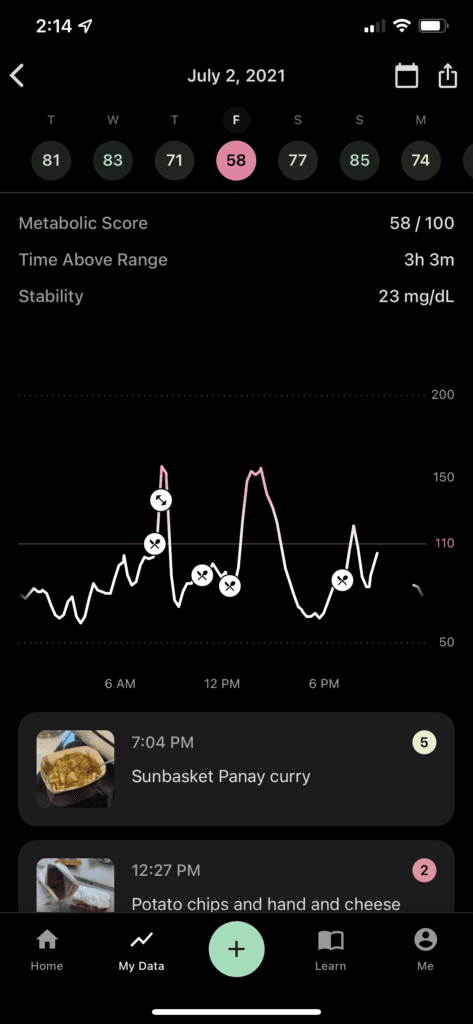
To only having some more gentle spikes:
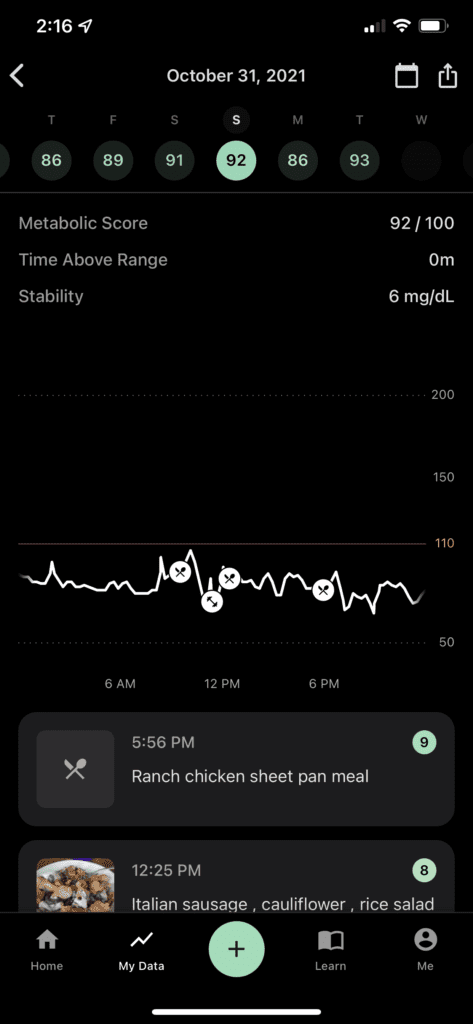
This really has been helping my health too. I mean, the lack of sleep has NOT helped, but other than that I really feel much more steady energy throughout the day, don’t get that 3 pm NEED to nap or eat sugar, and don’t feel irritated or grumpy throughout the day.
I was actually pretty surprised – I just had my yearly thyroid labs run and then came back completely normal even though I thought for sure that they’d be off due to my sleep issues. I really feel like this blood sugar control thing had a lot to do with that.
Summary
So these are some of the things I’ve noticed. Now as I mentioned in the beginning I do want to make it clear that if you were to do the same thing and wear a CGM you might find completely different findings.
You might not have a spike at all with rice but spike like crazy with a can of coke. Or you might have a 200 g of carb meal 3 x a day for a month and never see high blood sugars. That’s why I love and am so fascinated by things like CGM – because we ARE all so individual and different and these are the sorts of advanced in technology that can really uncover that and help us to get better.
But I did think that some of these were things that you should be aware of at least and might provide some insights for you as well – like “hey – Michele learned that she feels shaky and tired after eating a high carb meal because her blood sugar is spiking – maybe that’s why I feel that way too!”
And remember, you don’t need a CGM to find this out – read my last post on how to know if your blood sugars are fluctuating to find out the other ways I mention – but the closest thing to CGM would be to finger prick before a meal, again at 1 and 2 hours post-meal, and also any time you feel any symptoms like shakiness, the need to take a nap, confusion, dizziness, etc. Though, as I mentioned in the last post, I often feel the symptoms before I see the numbers move. So I might feel like I’m going high but the CGM/glucose meter still says 86 – but 30 minutes later my blood sugar has caught up and I’m at 130. So just something to keep in mind!
Anyway – I hope you found this helpful. The hormonal balance with something like an autoimmune disease can be so delicate and not having balance blood sugars really does make a difference, so figuring this stuff out for yourself can be a huge piece to the puzzle for you for lasting symptom-free health. And to help you with that even more, my next post will be things you can do to help balance your blood sugar.
See part 4 of this series: 10 Tips to Balance Your Blood Sugar


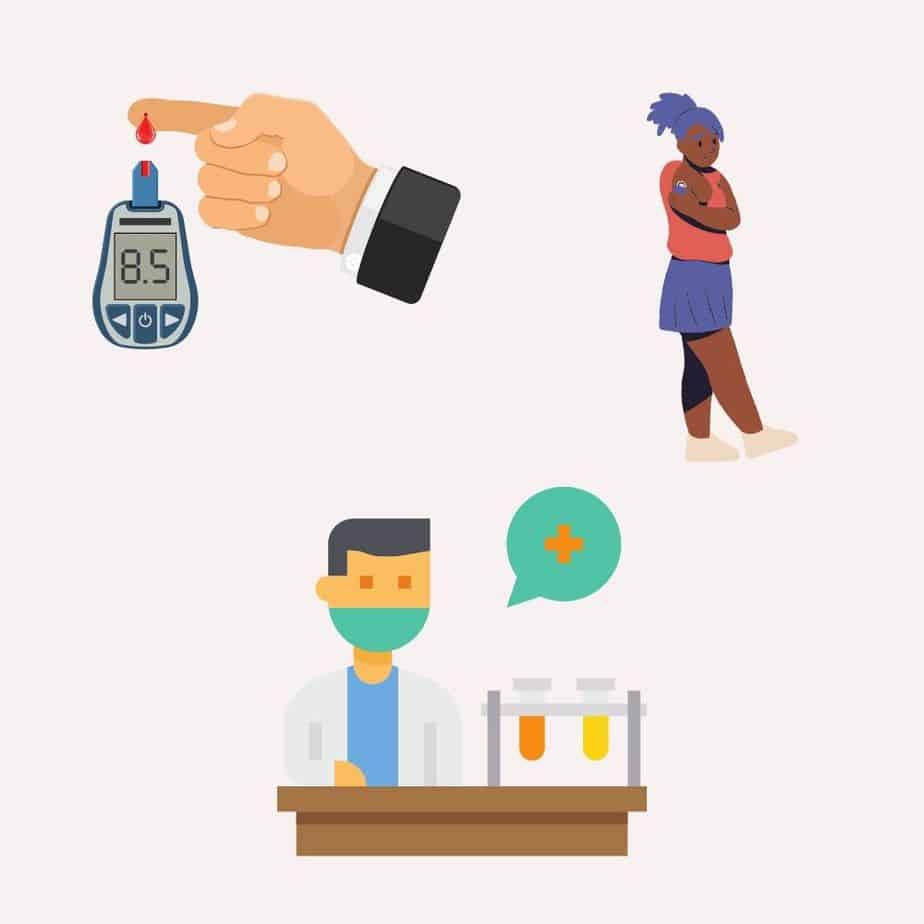




Hi Michele,
Love all of your articles! Have used a lot of your suggestions and want to say a BIG THANKS!!
I too experiment with food to see what reacts with me and causes flare ups.
Just recently discovered that MILK is a BIG no-no for me…any food that contains the slightest milk, immediately a flare up will start….
Thankyou again for all your help
Judy Page
Knowing that milk does that to you is solid gold information! So glad you’re finding value with my articles – appreciate you taking the time to let me know!
Wow! Dynamite post Michele. This helped me so much. I often think I feel better on keto and didn’t know why, but I feel like I need at least some carbs. I’ll be going along doing fine and then all of a sudden I’ll have a few days where I crash and burn — I just can’t seem to stay awake. I’ve looked at my food so many times, and I just can’t figure out what I’m doing wrong. The things you talk about in this post make so much sense. Although my son is grown and out of the house now, he also has type one diabetes so I understand your sleep deprivation. I learned from him that blood sugar levels make such a difference, but at the time he was diagnosed I had no idea of my own Hashimoto’s. I think I’m going to try this blood sugar monitoring on myself! Thank you so much for your always practical advice, and this especially insightful post.
You’re so welcome! I hope you can find some insights from monitoring it. You’ll see your swings are definitely a lot less dramatic than your son’s were, but they can still be at cause for your symptoms! (and glad to know I’m not alone in the sleep deprivation from T1D, lol – it’s crazy!!)
Hi Michele. Well, I’m three days into wearing my CGM! I’m completely obsessed with it, although I’m definitely still at the very beginning learning how to use it. It’s so surprising to see how food actually affects my body. So I’m coming back here to re-read your posts as I find your advice so helpful and practical. I’ll be seeing my son in two weeks when I visit over Christmas, so I can’t wait to get his input from his type 1 diabetes experience. Thanks again for all you do!
Oh I’m so glad you’re doing it! You’ll have to come back and share any insights that you’ve learned with us because I’d love to know others’ experiences as well.
Really great information and insight into dietary and lifestyle impacts on blood sugar. Thank you!
Thanks so much for reading! 💕
This is an awesome article! I have too, similar AI issues, plus I have Raynaud’s phenomena which, by some doctors, is AI disorder as well. When i made an experiment with my blood sugar, I didn’t have CGM, I just pricked my fingers like crazy:) but, I’ve got almost same results like you. Except, I dont eat rice (not a fan) and I eat very small amount of pasta monthly or even once or twice in 2 months (also not a fan). But, when I am regular in the gym – my data are so much better. I ‘ve learned that I have to be careful because when I workout too hard or too much, next day is a hell because of the headache that is almost impossible to endure. And it stays for some days. At the moment, I was not in the gym for 1,5 month. I am doing some flobility program at home and it is also weird because it spikes my blood glucose very high even on empty stomach. I am still figuring this out since I noticed that I feel kinda depressed for last few months. So, I dont have fun in working out which was my nr1. activity in the las 15 years. I also have a dog and walk with him a lot. But, overall less than two years ago. In 2019 my daily steps were around 10.000 to 12.000 and now are 7.000 to 10.000. I worked in extremely stressful enviroment but, interesting, I felt so much better. I changed the company in 2020, and got work in almost ideal working enviroment but feeling much worse.
Wow, this is fascinating, Michelle. Thank you for sharing. I just went to the Levels link and it says the product is still in beta?
Yeah, it’s in Beta – it took me a few months after signing up to be allowed in, but not sure what the latest is on that. There are other programs out there as well though (that I have no idea how they are or anything so can’t speak to them). But the beta just means they’re still developing the product to make it awesome – taking a LOT of our feedback to make it all better.